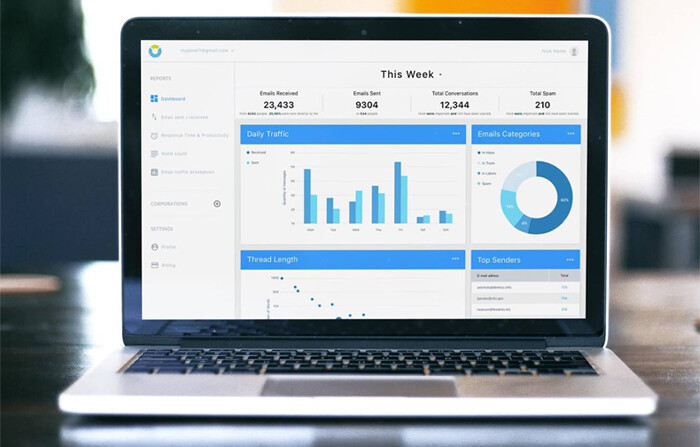Big data is being incorporated in many aspects of email marketing. It has made it surprisingly easy for organizations to track the performance of email marketing campaigns in fascinating ways.
How Big Data Changes Email Tracking
No matter what your role is, if you work in the technology sector, you likely spend a large portion of your day dealing with email in some way. You’re sending, reading, or reviewing emails, or you’re checking your inbox to see if anything else comes in. By some estimates, the average worker spends 30 hours a week checking their email.
Despite being such a centrally important and frequent job function, most of us are flying blind; we don’t understand how much time we’re spending on email, nor do we have a solid understanding of whether our efforts are productive. Fortunately, there are several new email tracking software tools that employers and employees can use to keep a closer eye on these metrics.
The problem is that previous email monitoring tools lacked the analytics capabilities needed to make empirically based decisions with the quality managers needed. Big data is making it easier for companies to get deeper insights.
Why Use Email Tracking Software Tools that Rely on Big Data?
There are many potential applications for email tracking software tools, but these are some of the most important:
- Productivity analytics. Studying how you email can alert you to the nuances of your email habits, including how often you send email, how long it takes you to write and read email, and what your busiest days and times are. You’ll learn what your worst habits are, so you can polish them and use your time more efficiently, and will learn to optimize your schedule to get more done each day.
- Sales and response metrics. Many companies rely on sales or prospecting via email, but if you aren’t gathering metrics like open rates and response rates, you may not be able to improve your process over time. Email tracking software can help you keep tabs on your progress, and may help you gather or organize information on your prospects at the same time.
- Employee monitoring. Employees waste something like 3 hours a day on unproductive activities, while most human resources departments only assume that 1 hour or less is wasted per day. Using some kind of email tracking can help you measure your employees’ productivity, and help you balance workloads between multiple employees.
Big data is at the root of all of these functions. It makes it easier for brands to get better insights.
The Best Email Tracking Software Tools that Leverage Big Data
Some email tracking tools focus exclusively on one email function, like tracking sales or marketing campaigns. Others offer a more robust suite of features, allowing you to track your overall productivity.
Whatever your goals are, these five tools are some of the best email tracking apps you can get your hands on. They all rely on sophisticated big data analytics systems.
1. EmailAnalytics

First, we have EmailAnalytics, which can be thought of like Google Analytics for Gmail. This tool integrates with your Gmail or G Suite account and visualizes your email activities into charts, graphs, and tables. It reports on metrics like average email response time, emails sent, emails received, times and days of the week that are busiest for you, and how long your average email threads tend to last. With the help of interactive data visuals and regular reports, you can quickly determine the weak points in your approach to email (and resolve to fix them). The tool also enables managers to view reports for teams or employees, so you can monitor team email productivity.
2. Microsoft MyAnalytics
Microsoft’s MyAnalytics isn’t quite as robust as EmailAnalytics, but it works quite well as a tool for time tracking Microsoft Outlook supports. With it, you can keep track of how you and your employees are spending the hours of your day, drawing in information from your email inbox and calendar. If you’re spending too much time in meetings, or too much time on managing your inbox, you’ll be able to figure that out quickly, and starting making proactive changes to your scheduling and work habits.
3. Streak
Streak is another Gmail tool, and one that attempts to convert Gmail into a full-fledged CRM platform. With it, you can convert messages into leads and prospects across various pipelines, and track your progress with each new prospective sale. It also offers built-in collaboration tools, so your team can work together on a single project—and track each other’s efforts.
4. Yesware
Yesware is designed with salespeople in mind, and it offers prescriptive sales analytics based on your email activity. With it, you can track a number of metrics within your email strategy, including open rates, click-through rates, and other forms of customer engagement. Over time, you’ll learn which strategies work best for your prospects, and can use those strategies to employ more effective sales techniques.
Implementing these email tracking software tools in your business can help you better understand how you and your employees are using email, improve your sales process, and spend less time on this all-too-important communication medium. Just remember, while data visuals and reports can be helpful in improving your understanding, those insights are only truly valuable if you take action on them.
Big Data Makes Email Tracking More Effective than Ever
Big data is changing the nature of email marketing. Companies can use more nuanced data analytics capabilities to drive their decision-making models in fascinating ways.